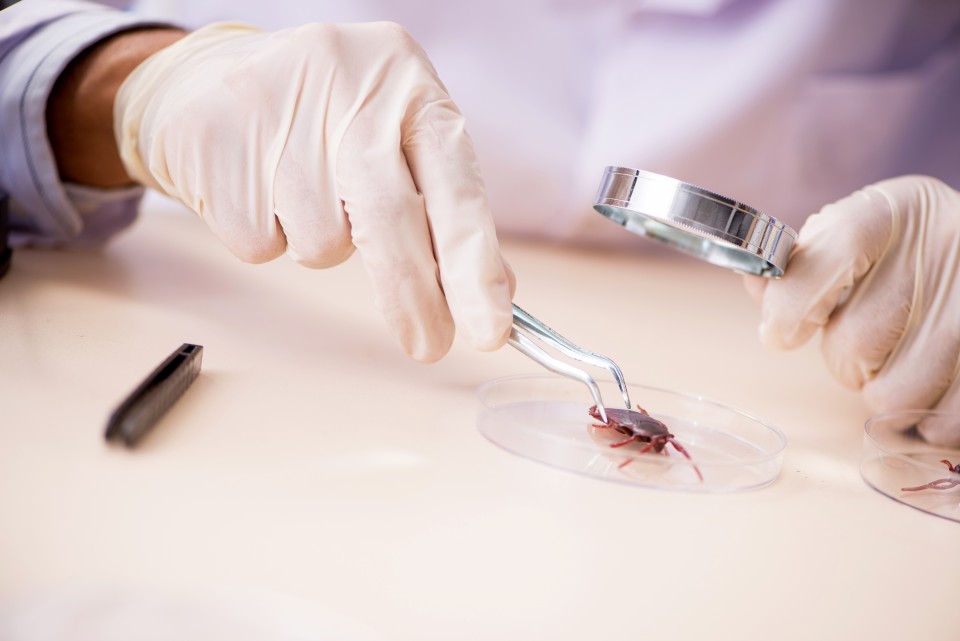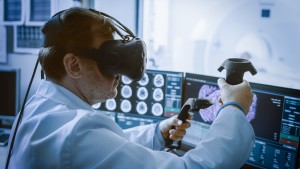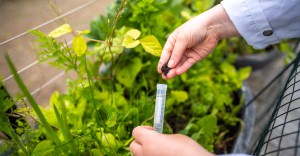
When Ellen Klinger’s general education entomology course transitioned online, she had to determine how to move her hands-on lab activities online.
During the in-person course, students had collected insects on campus and identified their collection using microscopes in the lab. Ellen valued the experience students gained during the labs but knew they wouldn’t gain much from staring at pictures of samples under a microscope on a computer screen.
For the online course, Ellen designed a new laboratory activity where students created insect traps using everyday items they found at home, such as bowls, sticks, and plastic wrap. Even without microscopes, students were able to identify the bugs they caught. They still gained experience collecting and identifying specimens, and they were able to do so in their own backyards.
Traditional, hands-on laboratory activities are generally considered a hallmark of undergraduate science, technology, engineering, and mathematics (STEM) courses. As online courses become increasingly prominent in STEM fields, many instructors struggle with how to conduct laboratory courses in the online environment.
This guide will help you understand the difference between virtual labs and distance labs, know their benefits and limitations, and explore best practices for transitioning your STEM labs online.
Background
Inquiry-based laboratory activities have long been known to increase knowledge, interest, and retention in STEM fields (Horsch et al., 2012; Kerr and Yan, 2016; Seymour et al., 2002; Wilson et al., 2018). Many instructors worry that these vital laboratory activities may be difficult, or even impossible, to conduct in online courses. However, research shows that non-traditional laboratory activities in online courses can be just as effective as traditional labs in face-to-face courses (Brinson, 2015; Faulconer & Gruss, 2018).
Non-traditional labs even offer some benefits compared to physical, in-person labs (de Jong et al., 2013; Faulconer & Gruss, 2018). For example, students can:
- Complete non-traditional labs at a time of their choosing and at their own speed (Faulconer & Gruss, 2018)
- Students can choose to engage with the activity at a time when they can learn most effectively, rather than the time listed on their course schedule
- Students can engage with the activity for as long as they need to understand the material as they are not restricted by the usual 2- to 3-hour lab block
Additional benefits, and drawbacks, will vary depending on the type of non-traditional lab you select for your course.
Virtual labs

Virtual lab experiences allow students to conduct simulated experiments through a computer (Faulconer & Gruss, 2018). Virtual labs can portray abstract objects, such as light rays, that students cannot see in a physical lab. Representation of abstract objects helps students understand the lab’s content better, especially with more complex content than if that representation is absent (Olympiou et al., 2013).
Another benefit to virtual labs is that students can conduct experiments on phenomena that would normally be unobservable or unsafe to observe (de Jong et al., 2013; Faulconer & Gruss, 2018). Climate change and evolution, for example, can be simulated using an online lab but cannot be taught in a physical lab. Many chemical reactions might also be unsafe to conduct in-person but could be easily simulated.
Virtual labs have been shown to increase students’ conceptual understanding (Kollöffel & de Jong, 2013) and procedural skills (Kollöffel & de Jong, 2013). The gains in conceptual knowledge achieved through virtual laboratory activities are equivalent to the gains achieved through traditional, physical activities (Barbeau et al., Zacharia & Constantinou, 2008; Zacharia & Olympiou, 2011).
Distance labs

Distance labs allow students to conduct experiments at home or in their local environment (Faulconer & Gruss, 2018). These labs can be completed with laboratory kits that are mailed to students or with everyday materials found at home or in local stores. Consider the opening story about Ellen Klinger’s entomology course. That distance lab was completed with everyday materials.
Students gain similar hands-on experience using equipment and carrying out the experiment when completing a distance lab compared to an in-person lab (Faulconer & Gruss, 2018). Comparative studies suggest that students can learn just as much from distance labs as they can from in-person labs (Casanova et al., 2006; Reuter, 2009).
In Practice
There are some steps you can take when deciding the type of online lab that will best fit your course. Most importantly, keep in mind that you need to be intentional and thoughtful about what lab you choose, what students will gain from the lab, how students will complete the lab successfully, and what technology tools might be useful in implementing virtual or distance labs.
Decide the learning outcomes for the laboratory activity.
Your learning objectives for the specific lab activity will be the most important factor in determining which activity type is the best fit. Think about the questions below:
- Why are students completing this lab activity?
- What do you hope students will gain from this activity?
- What should students understand or know how to do once they’ve completed the activity?
Review the statements below to see which options best match your goals for the assignment.
I want students to learn the physical skills necessary to run this experiment.
In this case, a distance lab is likely your best option. A laboratory supply company can provide students with all the equipment they need to safely conduct the experiment at home and learn how to use all the necessary equipment. If the equipment necessary to run the experiment is readily available in local stores or at home, inform students what supplies they will need as early in the course as possible, so they have time to locate or buy those supplies. Be sure to list any costs associated with distance labs in the syllabus so students are aware of these extra costs.
I want students to learn the conceptual ideas behind the experiment.
Although both options will help students understand conceptual ideas, a virtual lab simulation may be the best option if conceptual understanding is your goal. Virtual labs strip away the distractions of setting up the experiment and learning how to do the physical skills. Students can spend the entire lab focusing on making predictions, observing patterns, and interpreting the results to better understand the lab’s core concepts.
I want students to learn how to design experiments.
Distance labs, especially those created with at-home supplies, will give students the greatest flexibility to design their own experiments. Using readily available supplies or their local environment, students can have complete autonomy in designing an experiment of their choosing. One thing to keep in mind is that students’ home lives and environments may differ significantly. Make sure you offer multiple options for possible experiments and supplies. Some lab simulations also allow students to design the experiment. However, most lab simulations and lab kits require students to follow specific directions to complete an experiment that has already been designed.
Be intentional about student-instructor contact.

Traditionally, in-person labs have student-instructor contact built into the structure. When conducting either a virtual or a distance lab, you will need to be more intentional about making sure students have the support necessary to be successful. Ensure that your students have the opportunity to talk with you if they need help or have questions. You might consider creating a question-and-answer discussion board on Carmen for students to post their questions and observations. You will need to keep a close eye on the discussion board to ensure you can answer student questions in a timely manner. You could also host an optional, live question-and-answer session on Zoom so that students can interact with you in a way that is more like an in-person lab.
Allow students to collect their own data, whenever possible.
Instructors can provide students with data they have either collected or open-source data. If analyzing the data is the most important goal of the assignment, using existing data might be a good option. If possible, have students collect their own data. Students generally gain more experimental skills and learn the content more thoroughly when they are allowed to collect the data themselves rather than when they are handed data that has been simulated or collected by someone else (Klein et al. 2021).
Consider accessibility implications.
Taking accessibility into consideration is particularly important with virtual labs. Before selecting a virtual lab, ensure that all students will be able to use the program easily. Some factors to consider are:
- Do all videos and audio have captions and transcripts?
- Will a screen reader correctly read all aspects of the program?
- Can the entire program be navigated with just a keyboard?
- Will the program work with low-quality or unreliable internet access?
- Can the lab be completed on a phone or tablet?
Learn more about Ohio State's Digital Accessibility policies and review additional resources.
Leverage university technology to transition lab activities.
There are various university-supported and vetted tools you can use to help transition your in-person lab activities and assignments to the online environment. Explore some of them below:
Carmen Pages
You can link Carmen Pages together via hyperlinks to walk students through scenarios or simulations in which details about those scenarios can change.
A scenario could start with a prompt page and have students proceed through a few pages with embedded images, videos, and external simulators that lead to either:
- Static pages with questions that students should consider and respond to via Word docs
- Carmen Quizzes or Assignments in which students demonstrate their understanding of the scenario or simulation
View an example online simulation using interactive Carmen pages. This resource provides downloadable Carmen pages that you can adapt for your own course. View the examples and download content by visiting go.osu.edu/KTlabs.
Carmen Quizzes
The Carmen Quiz tool is a robust tool that allows the embedding of images and videos.
Consider using the One Question at a Time option to reveal information in chunks, in conjunction with the question type Text (no question) to embed images, videos, or links to videos or simulations.
For more information, see Build a Virtual Lab with Carmen Quizzes.
Carmen Assignments and Discussions
You can embed images, videos, or links in both Carmen Assignments and Discussions.
- If it makes sense to provide a general prompt with embedded items and students should work individually, use the Assignment option.
- If it makes sense for students to collaborate on general prompts with embedded items and respond to one another, use the Discussion option.
LabArchives
LabArchives is a cloud-based Electronic Lab Notebook application that allows users to electronically create, store, share and securely manage data. Students can use it as a space to record findings, organize their research, and record the experimental process, among other things. Learn more about LabArchives.
Microsoft 365
Use Microsoft 365 to upload a shared Excel file for your students to review and analyze existing datasets, either published from the literature, newly created, or from last year's classes.
Note: Microsoft 365 and is not available to employees of Wexner Medical Center.
Microsoft OneNote
Microsoft OneNote can be used as a digital laboratory notebook space. Students can insert images, links, and equations. Students can also share their notebooks with one another for group lab assignments and with the instructor. Watch Microsoft's overview to OneNote.
Note: This software is a part of Microsoft 365 and is not available to employees of Wexner Medical Center.
Microsoft Teams
Microsoft Teams can be used as a collaborative space where students can create channels to communicate in real-time and share files with one another. Watch Microsoft's overview to Teams.
Note: This software is a part of Microsoft 365 and is not available to employees of Wexner Medical Center.
Browse all Learning Systems Toolsets and this list of vetted Additional Tools for more tools that you might find useful in transitioning your labs.
Summary
- Online labs are as effective as in-person labs in teaching conceptual knowledge
- Each type of online lab has unique benefits and drawbacks when compared to in-person labs
- Before designing or selecting an online lab, carefully develop the assignment’s learning outcomes and use those outcomes to drive your decisions
- Think carefully about all aspects of the student experience when designing labs, including how they can ask questions and accessibility considerations
- Leverage existing university-supported tools to transition your labs to the online environment
References
Barbeau, M. L., Johnson, M., Gibson, C., & Rogers, K. A. (2013). The development and assessment of an online microscopic anatomy laboratory course. Anatomical Sciences Education, 6(4), 246-256. https://doi.org/10.1002/ase.1347
Brinson, J. R. (2015). Learning outcome achievement in non-traditional (virtual and remote) versus traditional (hands-on) laboratories: A review of the empirical research. Computers & Education, 6(4), 218-237. https://doi.org/10.1016/j.compedu.2015.07.003
Casanova, R. S., Civelli, J. L., Kimbrough, D. R., Heath, B. P., & Reeves, J. H. (2006). Distance learning: A viable alternative to the conventional lecture-lab format in general chemistry. Journal of Chemical Education, 83(3), 501-507. https://doi.org/10.1021/ed083p501
de Jong, T., Linn, M. C., & Zacharia, Z. C. (2013) Physical and virtual laboratories in science and engineering education. Science, 340(6130), 305-308. http://dx.doi.org/10.1126/science.1230579
Faulconer, E. K., & Gruss, A. B. (2018). A review to weight the pros and cons of online, remote, and distance science laboratory experiences. International Review of Research in Open and Distributed Learning, 19(2). https://doi.org/10.19173/irrodl.v19i2.3386
Horsh, E., St John, M., & Christensen, R. L. (2012). A Case of Reform: The Undergraduate Research Collaboratives. Journal of College Science Teaching, 41(4). https://eric.ed.gov/?id=EJ988861
Kerr, M. A., & Yan, F. (2016). Incorporating course-based undergraduate research experiences into analytical chemistry laboratory curricula. Journal of Chemical Education, 93(4), 658-662. http://dx.doi.org/10.1021/acs.jchemed.5b00547
Klein, P., Ivanjek, L., Kahlkemper, M. N., Jeličić, K., Geyer, M. A., Küchemann, S., & Susac, A. (2021). Studying physics during the COVID-19 pandemic: Student assessments of learning achievement, perceived effectiveness of online recitations, and online laboratories. Physical Review Physics Education Research, 17(1), 010117. http://dx.doi.org/10.1103/PhysRevPhysEducRes.17.010117
Kollöffel, B., & de John, T. (2013). Conceptual understanding of electrical circuits in secondary vocational engineering education: Combining traditional instruction with inquiry learning in a virtual lab. Journal of Engineering Education, 102(3), 375-393. http://dx.doi.org/10.1002/jee.20022
Olympiou, G., Zacharias, Z., & de Jong, T. (2013). Making the invisible visible: Enhancing students’ conceptual understanding by introducing representations of abstract objects in a simulation. Instructional Science, 41(3), 575-596. http://dx.doi.org/10.1007/s11251-012-9245-2
Reuter, R. (2009). Online versus in the classroom: Student success in a hands-on lab class. The American Journal of Distance Education, 23, 151-162. http://dx.doi.org/10.1080/08923640903080620
Seymour, E., Hunter, A. B., Laursen, S. L., & DeAntoni, T. (2004). Establishing the benefits of research experiences for undergraduates in sciences: First findings from a three-year study. Science Education, 88(4), 493-534. http://dx.doi.org/10.1002/sce.10131
Wilson, A. E., Pollock, J. L., Billick, I., Domingo, C., Fernandez-Figueroa, E. G., Nagy, E. S., Steury, T. D., & Summers, A. (2018). Assessing science training programs: Structured undergraduate research programs make a difference. BioScience, 68(7), 529-535. http://dx.doi.org/10.1093/biosci/biy052
Zacharia, Z. C., & Constantinou, C. P. (2008) Comparing the influence of physical and virtual manipulatives in the context of the Physics by Inquiry curriculum: The case of undergraduate students’ conceptual understanding of heat and temperature. American Journal of Physics, 76(4), 425-430. http://dx.doi.org/10.1119/1.2885059
Zacharia, Z. C., & Olympiou, G. (2011). Physical versus virtual manipulative experimentation in physics learning. Learning and Instruction, 21(3), 317-331. http://dx.doi.org/10.1016/j.learninstruc.2010.03.001

